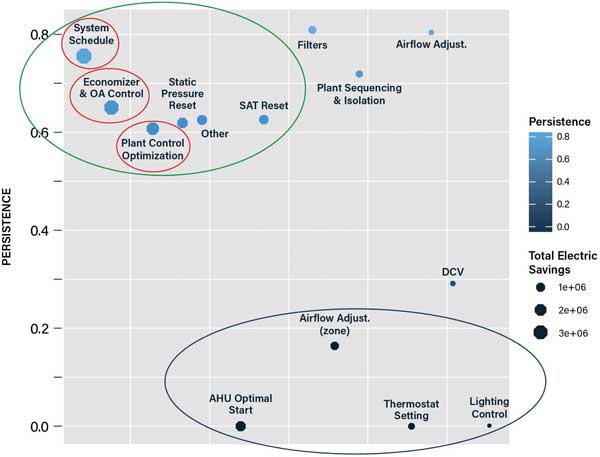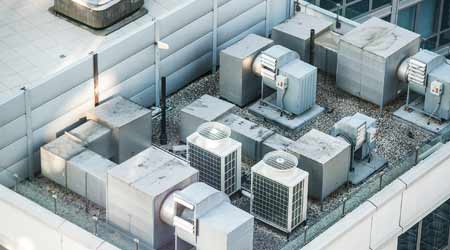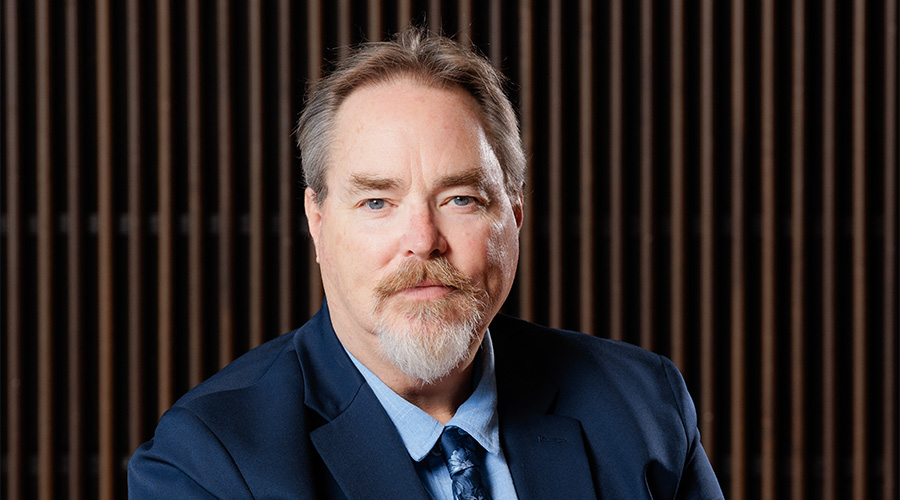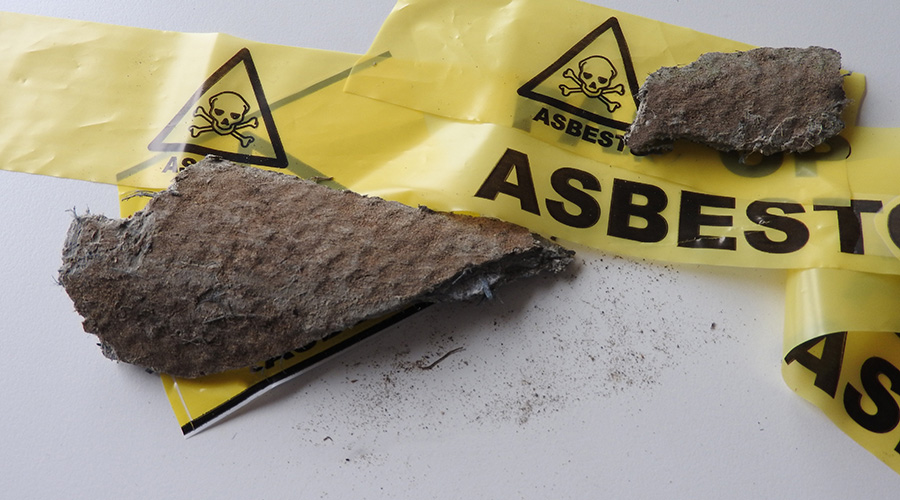How Retrocommissioning Leads to Long-Term Energy Efficiency
A recent study shows that retrocommissioning leads to persistent energy savings in commercial buildings.
By Saranya Gunasingh, Melanie Lord, and Scott Hackel
Retrocommissioning (RCx) in existing buildings is a process that aims to capture lost savings from inefficient building management practices. A bundle of energy efficiency measures that will augment building operation and save energy is installed during the RCx process. However, there is very little information on how long these energy efficiency measures will continue to provide savings over time, a quality referred to as persistence. Much current information is based on assumptions or estimates from a few studies showing wide variation: from 2 to 20 years for common RCx measures. The variation results because few of these studies are based on field monitoring of installed measures.
To understand how RCx measures perform years after the RCx effort is complete (persistence in savings), we conducted an in-depth literature review and found thirteen studies that evaluated savings from RCx. These studies showed that, when evaluated two or three years after RCx, 80 percent of the RCx measures were still operational. But we found little on persistence beyond the three-year mark and were not able to conclude measure-level persistence based on the literature review alone. Our next step was to conduct a field study to evaluate persistence in RCx measures. We identified 28 separate buildings that were past RCx participants in the ComEd RCx energy efficiency program. The goal was to quantify RCx measure persistence based on estimated useful life (EUL) and to identify operational factors and energy.
The 28 buildings were retrocommissioned in 2010/2011 (13 sites) and 2013/2014 (15 sites) through the ComEd RCx program. The RCx program recommended 231 measures across 28 sites, but only 167 were installed at the end of RCx. We gathered data on all 167 installed measure instances. We gathered data from these buildings in three steps: a pre-visit measure review based on the original RCx report, a site audit to quantitatively measure persistence, and finally, a site personnel interview to qualitatively identify factors influencing persistence. We categorized measures into 15 groups of the most commonly implemented RCx measures that accounted for 75 percent of the program savings. Those RCx measures provided the categories that were evaluated for persistence in the study:
• Airflow adjustment
• Airflow adjustment (zone)
• Demand-controlled ventilation
• Duct sealing
• Economizer and outdoor air (OA) control
• Filters
• Lighting control
• Optimum start for air handling units (AHUs)
• Plant control optimization
• Plant sequencing and isolation
• Supply air temperature (SAT) and reset
• Static pressure control
• System schedule
• Thermostat setting
• Other (includes measure instances with a negligible sample set, such as individual unit heater controls, fan staging modifications, etc.)
Each site visit involved a walk-through audit with direct observation of measures, usually via the building automation interfaces. We typically reviewed three months or more of specific data points for measure trends to evaluate whether the measure was still functional and to what extent. In situations where measure trends were not available (generally in older BAS systems without trending capability), we resorted to reviewing the operational strategy coded in the BAS system. In rare instances where neither of these methods could be employed, we manually changed measure setpoints and observed if the system responded as the measure was originally set up.
We evaluated all 167 installed measure instances for persistence in energy savings. We found a 60.8 percent persistence in electric energy savings across the RCx program. Sites retro-commissioned in 2010/2011 and 2013/2014 showed 76.4 percent and 49 percent persistence, respectively. This was counterintuitive to our expectation that more recently retro-commissioned sites would have higher persistence. On further analysis we found that two very large commercial facilities that were part of the 2013/2014 sub-group had very low persistence. These two sites had a negative impact on the overall persistence on the 2013/2014 dataset.
We also looked at persistence by measure category to understand the types of measures that had the longest energy savings potential from RCx. Measures on filters and airflow adjustments had the highest persistence, while measures on lighting controls, AHU start times, and thermostat settings showed the least persistence.

Figure 1 – Persistence by Measure Category. (Note: 1e+06 = 1,000,000 kWh, 2e+06 = 2,000,000 kWh, and 3e+06 = 3,000,000 kWh.)
Qualitative Factors Affecting Persistence
Based on data gathered from interviewing site personnel on building operation and maintenance, we analyzed key metrics that influence persistence of energy savings from RCx. Here are four noteworthy observations:
1. Persistence was significantly higher in sites where facilities personnel had received some training on the RCx measures, compared to sites where the personnel received no training at all. Staff that received training after the RCx were more knowledgeable about the installed measures and were better equipped to maintain measures over a longer period after the RCx was completed. It is important to provide post-RCx training to energy managers and other facilities personnel.
2. Buildings where the BAS system was managed by an external contractor showed higher persistence than buildings with BAS and energy managed by the facilities staff. Facilities staff are faced with occupant comfort requests and system maintenance priorities that need immediate attention. RCx measures were often overwritten while facilities staff catered to these high priority situations. External vendors were typically knowledgeable about RCx measures, and simultaneously managed system operations with long term energy savings goals in mind. This led to higher persistence in sites with externally controlled BAS and energy systems.
3. Buildings that had major retrofits after the RCx was completed saw a dip in energy savings persistence. Building and HVAC retrofits typically involve reconfiguring the existing zoning patterns and possibly, addition of new building equipment. Often RCx measures were overwritten or deleted from the BAS system after a major retrofit, causing a loss in energy savings.
4. Frequent staff turnover was another factor that negatively influenced RCx persistence. When facilities staff that were part of the original RCx effort were no longer employed at the site, knowledge about the installed measures and about maintaining those measures was lost. In some sites, staff hired post-RCx had little to no knowledge of the RCx effort and the measures installed, which led to degradation in savings.
How to Maintain Savings from RCx
Retrocommissioning an existing facility with operational improvements has been proven to be a successful strategy to achieve high energy savings. The RCx process is considered a success when persistence is higher than 50 percent. In our evaluation of 28 sites that were retrocommissioned three to six years ago, the RCx persistence was found to be 61 percent. More research is needed to evaluate and understand persistence beyond six years. Based on findings from this study, we recommend the following quality control processes to maintain savings post RCx:
• Persistence should be considered a high priority while RCx is being implemented. This ensures maximum measure life potential for all installed measures from the start.
• Benchmarking should be deployed using either basic energy management system software or even utility bills, to constantly monitor post-RCx operation and to help detect when persistence is sliding.
• A brief re-visit to retrocommissioned sites is warranted a couple years following major RCx activities. This re-visit should focus on checking measures for optimal operation and verifying energy performance via utility bills. This is not intended to be as time- and cost-intensive as the original RCx process, but rather to be a brief investigation with the opportunity to reinstate measures and capture lost energy savings.
• Follow-up monitoring is especially warranted when one of the correlating factors for low persistence is found to be true at a site. For example, a renovated building with internal energy management staff will be identified as a “high-risk” facility and will warrant diligent post-RCx monitoring.
The full report on this study can be found here.
Saranya Gunasingh (sgunasingh@slipstreaminc.org), LEED AP BD+C, is senior energy engineer for Slipstream. Melanie Lord (mlord@seventhwave.org) is senior project manager. Scott Hackel, PE, LEED AP, (shackel@seventhwave.org) is director of engineering.
Related Topics:













